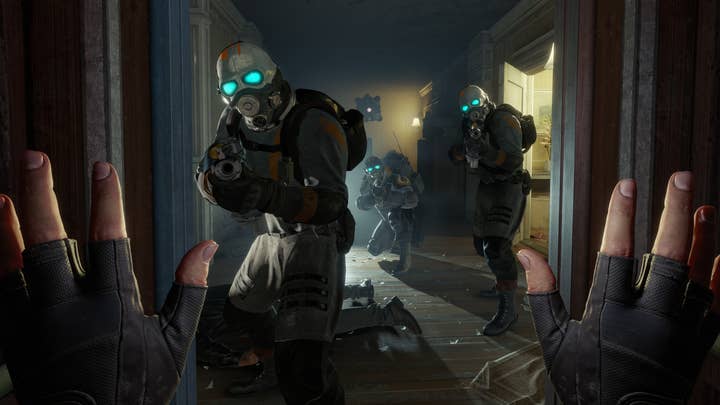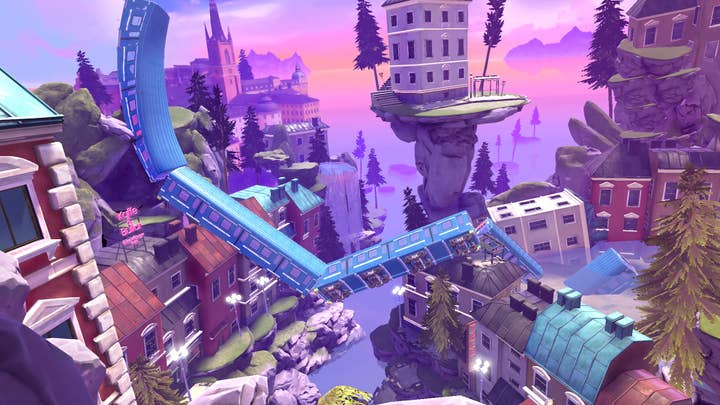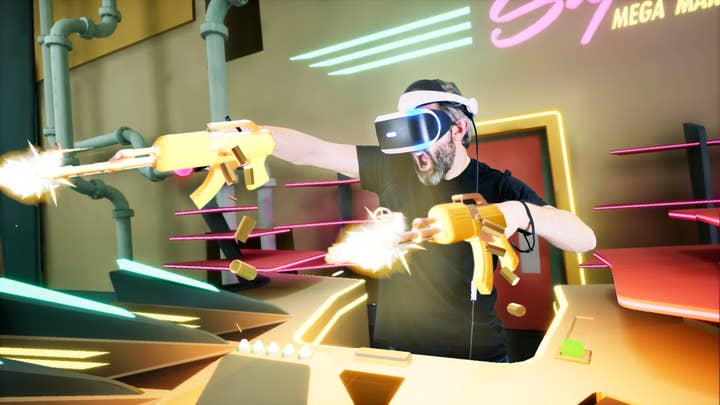The best practices and design principles of VR development
VR developers tell the GamesIndustry.biz Academy about the golden rules and design challenges of making games for virtual reality
The games industry has been waiting for virtual reality to explode and finally make it to the mainstream for five years. The release of the Oculus Quest last year, plus the recent launch of Half-Life: Alyx, have been steps in the right direction, but VR headset prices are still too steep for a lot of players.
For now, virtual reality is still a niche market populated by developers pushing the boundaries of what games can be. Developing for VR poses many challenges that traditional "flat screen" development doesn't have to tackle.
Key development concepts in VR revolve around locomotion, comfort, interaction and optimisation. But these are constantly evolving.
"It's difficult to determine what is a should and a shouldn't in VR. The only rule is that there isn't any yet"Nick Witsel, Vertigo Games
"It's very difficult to determine what is a should and a shouldn't in VR," says Nick Witsel, game designer at Arizona Sunshine developer Vertigo Games. "I think the only rule is that there isn't any yet. An interesting analogy is, back in the late '80s, we had the tech to do real-time 3D rendering but there were only a handful of games that actually did it. And later, we had games like Doom which were 3D in the sense of you moving through a level, but they used 2D sprites. And eventually we went to full 3D geometry.
"And during that entire process, we were trying to figure out: what does a 3D game feel like? What should a 3D game be like? I feel like with VR we're at the very start of that, but not only is it a different way of perceiving the world, it's a different way of being present in that world... So I think it's similar to that, but more challenging."
Some of the subtleties of developing for virtual reality are still being discovered, but there are essential rules that VR pioneers have identified already.
Be aware of the limitations of VR
During the first wave of VR games, a lot of developers just took popular existing concepts and translated them for VR. But time has proven that VR needs ideas tailored for its specific strengths.
"You need to identify what the medium is good at and what overlaps with your idea for the game," says Danny Bulla, co-founder and game director at Moss developer Polyarc. "VR has things it's really good at, and things it's not good at -- and a lot of people skip that step of asking: hey, what can this medium do that others can't? Usually they just want to bring an idea from another medium and rubber stamp it."

Reviewing ideas quickly and discarding the ones that don't work takes a whole new dimension in VR, especially if you're new to the medium.
"The blueprints and assumptions you have based on traditional game design do not work in the same way when it comes to VR," says Steve Watt, creative director at nDreams. "So iterating quickly in the engine, failing fast, and learning from what works is absolutely critical."
There are things that you simply can't do in VR -- or rather shouldn't try to do -- such as any type of combo-based combat mechanic or very cinematic experiences.
"To do something that actually requires timing as precise as you'd find in a Street Fighter game is just not gonna happen," says Erik Odeldahl, creative director and co-founder of Apex Construct developer Fast Travel Games. "Of course, we can render a third-person dude in the game and have it respond to button inputs, but that's not fun -- that's not VR.
"Flat screen can learn from VR, move away from stuff that is too much film and too little game"Erik Odeldahl, Fast Travel
"[Looking] at long cutscenes [with] the camera controlling everything you see -- that's not gonna happen either. The challenge is finding ways to tell stories that don't need that. And I think maybe flat screen can learn from VR, move away from stuff that is just too much film and too little game."
Even simple concepts need to be redefined for VR. For instance, players take things much slower in VR than they do in a flat screen game.
"People slow down so much [in Half-Life: Alyx]," says Valve's designer and writer Sean Vanaman. "That's in contrast to how fast your character moves in Half-Life games traditionally. You're very, very, very fast in those games, and at the furthest end of the bell curve on the other extreme is how slow people go [in VR]."
If something looks interactive, it has to be interactive
Interactions in VR are more important than in flat screen development, simply because players expect to be able to act in-game the same way they would in real life. For instance, if there's a panel with a lot of buttons to push, you want to be able to push all these buttons.
"If anything looks interactable, it has to be interactable," Odeldahl says. "The player has to be able to touch it, lift it, throw it or press it, whatever the interaction may be. I think that's the most important [rule] of all.
"A lot of us here [at Fast Travel Games] have experience with AAA games, and it's so easy to get realism and believability by just cramming in tons of detail and not let the player interact with it. But if you put rubbish in the corner, or books, or kitchenware, in a VR game, you have to let the player interact with it. A super detailed world is not going to save a world that [is not interactive]. Nail the interactions and let the rest follow."

You also need to take into account that people are not necessarily going to interact with the environment in the way you expect.
"When playing a game like Halo, you can hold the X button and you'll open up a vault," Bulla says. "But in VR everyone's going to try to want to do that in a different way. And it's good to make sure that you're accounting for a majority of [them]. Testing is a really great way to help figure out all the different ways people want to interact with your game."
When Valve started making prototypes for what was going to become Half-Life: Alyx, it created short gameplay sections using greybox spaces and filling them with enemies, items to find and furniture, and then watched players move through them. That helped to identify what players were trying to interact with and adapt the level accordingly.
"Players would lift up the box, they would look under the table, stick their heads in the vents," says Valve level designer Corey Peters. "We watched player after player do this, and it gave us an opportunity to spend resources effectively on putting things under the box, and in the vent. It offered us the excuse to reward that type of exploration."
Always keep comfort in mind
Another concept that should always be at the back of your mind is players' comfort, with motion sickness being a common side effect of playing in VR.
"I like to think about each player having their own comfort bucket -- that's the way that I refer to it," Bulla says. "It's like a bucket of water, but instead of it being filled with water, it's [filled with] uncomfortable feelings. [When] making entertainment the first goal is to not make people uncomfortable, right? You can't really immerse people into your stories if they're uncomfortable.
"It's a lot easier to overwhelm players in VR, [it's] inherently a physical experience"Danny Bulla, Polyarc
"We each have our own different size buckets. We need to make sure that if we're doing things that are going to fill up people's buckets -- like a more heavy cognitive load section -- that we are managing to empty out that bucket too, so it doesn't overflow. It's a lot easier to overwhelm players in VR than it is in traditional screen gaming. Virtual reality is inherently a physical experience. Much more physical than sitting on the couch with the controller in your hand."
The challenge is balancing immersion, freedom and comfort, as once players put the headset on, they really believe they're in this environment.
"You're going through all the same emotions that you would if you were there," Peters says, referring to Half-Life: Alyx. "If you have a situation where there's a headcrab in that room, it's much scarier than when it's on your monitor. We really had to be cognisant of pacing those types of experiences out. There are parts of the game that will be intense, but then we try to have a moment afterwards where you can breath, take your time a little bit, explore -- just gather yourself back up."
Be gentle with your difficulty curve and pacing

VR is still a new medium for a lot of players, so it's important you take the time to build up the difficulty, and give enough time for the player to familiarise themselves with the environment and the controls before throwing more complicated things at them.
"We really worked hard on giving you a good pacing experience in the beginning of the game -- to build up your new skillset as you explore the environment," says Peters about Half-Life: Alyx. "It's one thing to make a regular shooter and assume that the player knows how to move around and fire their weapon, but in VR it's such a physical experience that you have new skills to learn.
"A big portion of the early part of the game is you learning how to use a pistol, how to reload the pistol, and fire at enemies. We try to slowly increase the level of threat over time, so when you start out you're fighting a barnacle -- a barnacle is not a tough enemy to fight, but it's gonna get you to reload your gun, and learn that skill over and over again."
Work around having no camera control
In VR, the player has complete control over the camera view at all times, which means that if you want them to follow a specific route, you'll have to guide them all the way.
"While agency is one of the strengths of VR, not being able to take this away from the player is one of the challenges we need to overcome," nDreams' Watt says. "Detail and lighting can play a big part in telling people where to go."
Odeldahl adds: "You never know where the player is looking, which means that there's many cheats that you can use in flat screen that you just can't do [in VR]. And you really can't take the camera control away because that's just going to get people to throw up.
"If you really need the player to look at something, make sure it is quite loud and probably blinks. You do this in a flat screen FPS as well, but you really need to almost go to the extremes in VR in some cases."
"If you need the player to look at something, make sure it is loud and probably blinks"Erik Odeldahl, Fast Travel Games
Focus on player movement
The way you're going to allow the player to move is crucial to a good VR experience, especially in a game where the player embodies the main character -- like in Half-Life: Alyx for instance, as opposed to controlling the main character, like in Moss.
"A big topic when it comes to VR and accessibility is the concept of VR legs," Witsel says. "When I play a VR game, I'm standing still, my legs are standing still. So if I see my VR legs move around, there's this disconnect. For some people that's fine. Personally I don't like seeing my legs in VR because they never match with what my real legs are feeling so I'd rather not see them at all.
"What a lot of FPS games also have is that you can just jump. With VR in general, it can be a bit of an issue, because you're standing on the ground, but your character jumps up. There's a chair over here, beside me -- I could stand on that chair, but how does that work in VR? That's a thing you have to think about."

Half-Life: Alyx opted for a system where your character simply teleports instead of jumping, highlighting how you have to work around even the most basic mechanics in VR. In addition, movement with your hands and head usually must be replicated one-one in the virtual world, and that can create unexpected challenges.
"What if you're playing a game where you've got this huge axe and it's really heavy," Witsel points out. "Well it doesn't weigh anything [in VR], because I can just move my hands around. You have games, like Saints and Sinners, where it actually slows your hand movement. So while I'm doing this in real life [he moves fast] my character does this [he moves slowly]. For some people that's absolutely fine. For other people... this is actually taking [them] out of the experience."
Choose your locomotion mechanics carefully
The second step of making decisions on movement in a first-person view is choosing your locomotion mechanic -- how the player is going to move about in the world.
You can go for smooth locomotion, which allows the player to move their character using an analog stick, the same way they would in a flat screen game. Smooth locomotion is usually paired with either smooth rotation or snap turns using the second stick, so you can turn your character's entire body to face in another direction.
"As every person is slightly different in their sensitivity to motion in VR, exposing as many options and adjustments to the user as possible is a good way to increase accessibility," says Grant Bolton, technical director at nDreams.
"Exposing as many options to the user as possible is a good way to increase accessibility"Grant Bolton, nDreams
For some people, smooth locomotion can be very nauseating, as your eyes see a movement that your body isn't physically following.
"The extreme example is a roller coaster," Witsel explains. "Roller coasters in VR would be absolutely nauseating because you're experiencing movement, deacceleration, acceleration without actually feeling it and your mind goes absolutely nuts when it happens -- a lot of people get really sick."
Limiting the field of view can be a good trick for avoiding motion sickness when using smooth locomotion -- developers call it 'tunnel vision', 'vignettes' or 'blinders', and Ubisoft's Eagle Flight was one of the first to use it.
"A very early example would be Google Earth VR -- whenever you go to a certain location, the field of view narrows," Witsel continues. "So you basically get these black borders around your vision, which makes it easier for your body to understand that you're looking at a screen while you're flying towards a place, rather than being part of a world."
The other locomotion option in a first-person VR game is teleportation -- point at where you want to go, press a button, and you're transported there.

"Apex Construct launched with teleportation as its main locomotion mechanic," Odeldahl says. "But we implemented a smooth locomotion control scheme just before launch, because lots of people really loudly declared online that they wanted it. And it turns out more than half of our players actually use smooth locomotion and very much prefer that. Lots of players don't want to play teleportation-driven games.
"AI is often reliant on knowing where the player is and in which direction [they're] moving, and when you can teleport five meters in the blink of an eye, that makes some gameplay really, really hard to implement -- or AI breaks. So our current title is built around smooth locomotion as the default, not alternative."
There are also a lot of "diorama" experiences in VR that do not require either smooth locomotion or teleportation, such as Fast Travel's The Curious Tale of the Stolen Pets. Its initial design intent was to create a game that anybody could pick up.
Polyarc's Moss was also designed to be an experience for people who never played in VR before, and Bulla believes there's space for more of these.
"As much as people want to create deep and meaningful systems that keep players engaged, I think that there's also players who want low friction experiences that they can share with their friends and family," he says. "Identifying the type of experience that you're trying to create early on is very important to focus on those things too."
"There's players who want low friction experiences that they can share with their friends and family"Danny Bulla, Polyarc
Be consistent with level metrics
In flat screen development, studios can cheat a lot with scale, making things look a lot bigger than they actually are. This is impossible in VR, so you need to build everything to scale and be consistent with it.
"If you were to compare the mountains in Skyrim to real mountains in real life, they wouldn't add up," Witsel says. "Mountains are a lot smaller in Skyrim -- they add all these effects to make it feel like something is far away. But in VR you're working with both of your eyes and you can instantly tell it's not that far away -- it's just small. You perceive scale a lot more accurately in VR.
In addition to scale, you also need to make sure that spacing is consistent within your world.
"Anticipation plays a big factor into comfort," Bulla says. "So create consistency in your metrics: what is the most comfortable angle to jump at? What's the most comfortable size of a door for the character to move through? All these things are standard in traditional game design and level design, but it becomes so much more important in virtual reality as you're immersed, and so your brain can recognise things that are a little off."

Use positional audio to keep players immersed
Having every sound coming from an actual source is crucial in VR, to improve the player's immersion.
"[Positional audio] is not just a mechanic to get people to look or move in the right direction," Odeldahl says. "It's equally important as your visual style and your modes of locomotion and interactions, just to get players to believe in the world they're in.
"VR to me is completely uninteresting if you don't believe in the world you're in, because typical flat screen games are so evolved when it comes to game design and level design, and there's so many things you can't do in VR. So I think you counter that with just making sure that the player completely believes in the world you're building once they've got the headset on. Because that is something that flat screen can't do."
Going back to the idea of comfort and balancing the player's cognitive load, positional audio can help in that respect too.

"In those moments where you want the player to chill out and become immersed, audio and character performance can totally carry that for you," Bulla says. "I've noticed so many times that players are just fine sitting in Moss and just listening to the world and moving [main character] Quill around.
"[This] really helps with the immersion and the intimacy of the experience. If you want to keep players engaged, you need to keep them immersed -- [if] they're not immersed, they're gonna take off the headset and then that's a whole new thing to get them to put the headset back on."
Choose your technology carefully
With it comes to VR, engine choice is more restricted than in traditional development. It will essentially boil down to choosing between Unity and Unreal. If you're unsure about which one fits your project best, you can read our guide to Unity here and our guide to Unreal on this page.
Both have advantages and disadvantages when it comes to developing for VR, so choose an engine you're comfortable with. However, if you have experience in both, you may find you prefer one over the other -- Fast Travel switched from Unity to Unreal after three VR games, for example.
"There were so many systems that we had built in Unity that Unreal more or less had out of the box," Odeldahl explains. "We're a fairly small studio and we keep supporting our own games after release. And we just felt that we needed to spend less time [building] systems; plus some of our systems weren't necessarily fully compatible with later versions of Unity."
Separate from the specific engine, it's also important to look for the tool suite that supports what you're trying to accomplish.
"Utilise the marketplace of each of those engines and utilise the plugins that come with them," Bulla says. "You're gonna have so much work to do, solving these mechanical problems and challenges in VR, that you certainly want all that other stuff that's already been figured out done for you, so that you can really focus on the user experience and the interactions."
"We target all platforms as long as they have motion controllers. You have to build something that scales"Erik Odeldahl, Fast Travel
Think multiplatform from day one
Because the VR market is still fairly small, you should build your game with multiple platforms in mind from the start.
"We target all platforms as long as they have motion controllers," Odeldahl says. "So you have to really build something that scales. We've also said that we want gameplay features parity on all platforms... We never develop for just one platform and then port.
"In traditional gaming, maybe you focus only on the Switch or only on PC, and you can get a publisher and they can help pay for porting the game to other platforms. There's not a lot of that yet in VR. We make sure we hit all the platforms, we make sure that it's stable on all platforms. To be frank, that's an easier way to make sure that you make money from your games and keep people working."
Even Moss, which initially was a PSVR exclusive, was designed with multiplatform in mind from day one.
"We knew that we wanted to be in the hands of as many players as possible, and so we designed the game to be able to work on the lowest common denominator of buttons and interactions," says Bulla. "So we had a trigger, a couple of face buttons and an analog stick and we knew that each of [the VR platforms] were going to have that."

Always think about your performance targets
Developers always have to take performance into account, especially in the AAA space. But in VR, even indies need to keep it in mind at all times.
"The main difference in hitting VR performance targets is that we have to render to a high-resolution pair of screens at a very high framerate -- somewhere between 60 and 144 frames per second depending on the platform," Bolton says. "We also have to provide a consistent framerate without the kind of minor hitches that might be acceptable in a non-VR game -- this means we always have to optimise for the worst case rather than the average case."
Fast Travel Games usually scales upwards in order to hit the performance targets of each platform.
"It's [about making] sure that we hit performance on the 'weakest platform'," Odeldahl says. "We build for the Quest, and then we scale upwards, all the way up to 144 hertz [for] Index. If you make sure it works really, really well on the Quest, you're not gonna have any issues making sure it works really, really well on any PC platform. We think of performance all the time, every day -- every single check-in we do to the game, we have performance in the back of our mind."
"We have to provide a consistent framerate without minor hitches that might be acceptable in a non-VR game"Grant Bolton, nDreams
Your game won't be accepted on storefronts if it doesn't meet each platform's performance requirements -- part of Oculus Rift's prerequisite is to be able to display graphics in the headset at 90 frames per second for example. You can read more about the requirements to launch a game on Oculus in this guide.
In addition, a VR game not hitting performance targets will at best be less enjoyable, at worst unplayable and nauseating.
"We've noticed that if you playtest a VR game below 45 frames per second, or even below 90, your enjoyment just goes down," Witsel says. "People don't exactly know why [but] they're like: 'This isn't it.' And when you have them play something that's at a stable frame rate, they are like: 'Oh this is so much better, what's different?' It's literally only the frame rate."
Don't underestimate testing
Testing your game as you develop is crucial for every project, but even more so in VR. It also requires a bit more personal investment and elbow grease, so plan your development schedule accordingly.
"The main differences are that testing your work is more involved as you need to put on your headset and pick up controllers," Bolton says. "It's hard to automate testing as the inputs are so precise and analogue. Additionally, reviewing software as a group is challenging! The social screen -- where we mirror the VR view on a TV -- helps, but it's hard for an observer to get the same feeling from the software as the person playing."
Even the simplest tasks take different dimensions in VR, so the best thing is just to approach it like a blank canvas.
"Throw everything you know about 2D games out of the window," Witsel concludes. "Just throw it all out the window and start from scratch. What can you do? What can you build revolving around being able to to pick things up or move my hands and look around? Just start from there."
-Additional reporting by Matthew Handrahan-
The GamesIndustry.biz Academy guides to making games cover a wide range of topics, from finding the right game engine to applying for Video Games Tax Relief, to tips for making a cross-platform game, or even how Ori and the Will of the Wisps was built with 80 people working from home. Have a browse.
